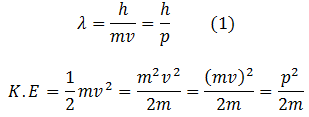Each of the following questions is followed by four
answers. Select the correct answer in each case.
- If the K.E of a free
electron doubles, its de Broglie wavelength changes by the factor
| √ 2 | 1/√ 2 | 2 | ½ |
Solution: De Broglie wavelength is

Now let the K.E is doubled, i-e, 2K.E. Then the linear
momentum may be p’. Therefore,

If λ ‘ is the new wavelength when the K.E is
doubled, then put this value from (2) in equation (1).

Thus the wavelength changes by a factor 1/√2.
2. Einstein’s photoelectric equation is Ek = hf – ϕ. In this equation Ek refers to
(a) K.E of all emitted electrons
(b) Mean K.E of emitted electrons
(c) Maximum K.E of emitted electrons
(d) Minimum K.E of emitted electrons
Explanation: The equation explains the conservation of energy concept in the case of photoelectric effect. The energy of the incident photon is partly used to escape the electron from the metal surface, called work function ϕ, and partly in accelerating the ejected electron from the surface of metal. Therefore, if hf is the energy of photon and ϕ is the work function of the metal, then their difference is the maximum K.E of the electron. See some details in comprehensive question 3.
3. De Broglie wave are associated with
(a) Moving charged particles only
(b) Moving neutral particles only
(c) All moving particles
(d) All particles whether in motion or at rest.
4. A perfect absorber must also be perfect
| Cavity | Source of radiation | Radiator | None of these |
5. Pair production occurs only when energy of photon is at least equal to
| 1.02 keV | b. 1.02 eV | c. 1.02 MeV | d. 1.02 GeV |
Explanation: In the process of pair production, a
photon of energy hf disintegrates into the pair of electron and positron. The
excess energy of photon is used as the kinetic energies of electron and positron.
Since the rest masses of electron and positron are equal, therefore,

Now m0c2 = 0.51 MeV, this implies that
2m0c2 = 1.02 MeV.
Therefore, the energy of the photon must be at least equal to 1.2 MeV. For further details, see comprehensive question 5.
6. Pair production cannot take place in vacuum because
| (a)Mass is not conserved | (b)Momentum is not conserved | (c)Energy is not conserved | (d)Charge is not conserved |
Explanation: Pair production takes place only when
there is a nucleus in the vicinity (surrounding). In this process the charge,
energy and momentum are conserved. The role of heavy nucleus is to share some
energy and momentum for their conservation. Therefore, pair production is not
possible in vacuum.
7. The positron has a charge which is in magnitude equal to the charge on
| Electron | Proton | β particle | All |
Explanation: Positron is the anti-particle of
electron. It has the same charge as the electron. All the given particles have
charge equal in magnitude (sign of the charge is not considered as per
condition of the question).
8. We can never accurately describe all aspects of subatomic particles simultaneously. It is correct according to
| Uncertainty principle | De-Broglie theory | Einstein theory | Photoelectric effect |
Explanation: Uncertainty principle of Heisenberg states that it is impossible to determine both position and momentum simultaneously. For further details, see comprehensive question 8.
- An electron microscope
employs which to one of the following principles? - Electrons have a wave
nature - Electrons can be focused by
an electric field - Electrons can be focused by
a magnetic field - All of the above

I like your efforts
God bless you
I need your help
Memoona
Thank you so much.
I like your efforts
God bless you
Pingback:Numerical Problems, Advent of Modern Physics … msa – msa
Pingback:sq-ch18-p12 – msa
Pingback:long-questions-ch-18-p12 – msa
Pingback:Physics 12 – msa
Pingback:Numerical Problem 13, Advent of Modern Physics … msa – msa
Pingback:Numerical Problem 1, Advent of Modern Physics … msa – msa